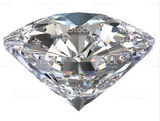Diamonds
What are Diamonds?
 Diamond formed billions of years ago from almost 100% pure carbon under the extreme heat and pressure hundreds of miles under the Earth. The crystals, shown at right, have been brought near Earth's surface in lava tubes. Diamonds are extremely rare, and are the hardest substance known to man. Once cut and polished, they possess optical properties that gather light and reflect light as fire and brilliance.
Diamond formed billions of years ago from almost 100% pure carbon under the extreme heat and pressure hundreds of miles under the Earth. The crystals, shown at right, have been brought near Earth's surface in lava tubes. Diamonds are extremely rare, and are the hardest substance known to man. Once cut and polished, they possess optical properties that gather light and reflect light as fire and brilliance.
How To Select A Diamond
The 4 C's of Diamond Quality

Cut refers both to the diamond's shape and its proportions, symmetry and polish. Cut is the quality of the diamond we control, and affects both the diamond's visual size and it's brilliance. A diamond that is too deep or too shallow will not shine as brightly



Diamond Shapes
An ideal cut diamond describes the ideal proportions, symmetry and polish of the diamond. There are ideal measurements, angles and proportions that a diamond cutter should adhere to that will allow the diamond to give the most brilliance and fire. Marcel Tolkowsky, a mathematician and diamond cutter, developed the formula in 1919 for the modern round brilliant cut that is still used today. Unfortunately, the term ideal cut is widely misrepresented to describe a diamond of only average cut quality. Even many lab report firms will loosely use this term or have their own set of standards. Don't buy a diamond or pay a higher price just because someone says it is an ideal cut. Remember there are many variables that will produce a beautiful diamond, and just as many that can produce a poor one.
There are many diamond shapes to choose from, here's a few;

Why do diamonds of the same carat weight appear to be different sizes?
Diamond Pricing
What quality diamond is the best for the money?
How is the price of a diamond determined?
Each diamond's price is set by the industry and is based on its rarity. A larger and more perfect quality diamond is rarer than a small or less perfect diamond. We work hard to find the right price from our diamond site holders and then keep our overhead costs low so that we can offer you a beautiful diamond at a great price.
Am I getting the best price on my diamond or jewelry?
Do I need to ask for a discount?
What's the difference between appraisal value and retail price?
Jewelry appraisals are confusing. It's common practice to "appraise" a piece at 2 or 3 times the real retail price, giving the false satisfaction that one's getting a real bargain. Unfortunately, the cost is that it needlessly inflates your insurance premiums. A Replacement Value Appraisal should be for the retail replacement before any discounts. There are other reasons you might need an appraisal, such as court or estate settlements, and the value scale will be reduced as a Used Sale Value. We can provide these jewelry appraisals.
Can I find something similar cheaper elsewhere?
There is hardly anything in the world that someone cannot make a little worse and sell a little cheaper, and the people who consider price alone are that person’s lawful prey. It’s unwise to pay too much, but it’s worse to pay too little. When you pay too much, you lose a little money — that is all. When you pay too little, you sometimes lose everything, because the thing you bought was incapable of doing the thing it was bought to do. The common law of business balance prohibits paying a little and getting a lot — it can’t be done. If you deal with the lowest bidder, it is well to add something for the risk you run, and if you do that you will have enough to pay for something better.
Alternatives to Natural Diamond
Man-made or laboratory-grown diamond crystals are chemically and physically the same as the natural stone, and cost almost as much. Experience shows that man-made stones are not worth nearly as much as a natural, mined precious gemstone.
There are 3 alternatives that have met with some success. Cubic Zirconia, or CZ, is a man-made material that most resembles natural diamonds. CZ can be clear or colored. It's not nearly as hard as diamond, and after a year of normal wear can look quite dull. White Sapphire, another diamond substitute, is harder than CZ, but does not have the brilliance or fire of a diamond. Man-made Moissanite has the hardness of sapphire and to the untrained eye a brilliance similar to diamond. Most have a yellow, green, or brown tint, and is more expensive than cubic zirconia or white sapphire.
Could I be buying conflict diamonds?
Absolutely not. The site holders from whom we buy diamonds are two of the largest American-owned and run diamond firms. They purchase from mines that adhere to the Kimberley Process to ensure that diamonds are conflict-free.
How do I keep my ring clean and shiny?
Most importantly, have your jewelry professionally cleaned and inspected. We'll steam, ultrasonically clean, and polish your fine jewelry at no charge. We'll check gemstone security and recommend proper cleaning for you at home.

